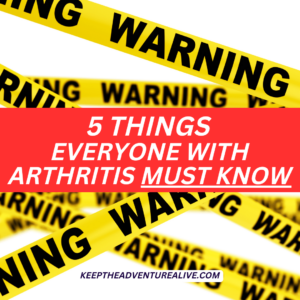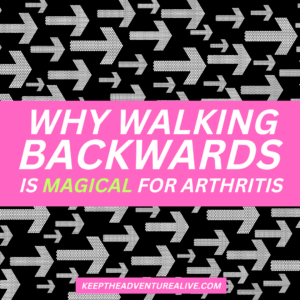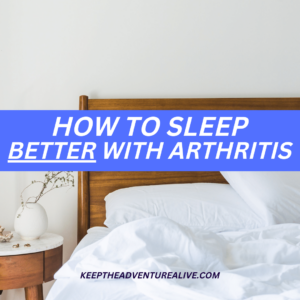In order to keep running with knee arthritis we have to make sure we understand what osteoarthritis is, have appropriate single leg strength, and adequate balance to make sure our body is ready. It is possible to continue running despite knee osteoarthritis and it has actually been found that running may improve osteoarthritis symptoms. Various research has proven that self-selected running is not associated with increased joint space narrowing or progression of the disease. In order to reap the benefits of running, instead of increased arthritis pain, we have to make sure our joints are prepared to handle the stress.
“I have been having knee pain off and on for the past 2 years. I used to love running, especially trail running. I would run about 20 miles per week. My knee pain started getting more consistent after 1 mile, every time I tried to run. My doctor had mentioned arthritis which scared me. Now I am scared to run because I don’t want to be making my knee worse. I have resorted to lower impact exercise but I really miss running. What should I do?”
This is an extremely common scenario that I hear all the time. Chronic joint pain, mention of arthritis, and thus initiation of fear, especially of running. I’m here to tell you today that running with knee arthritis is actually okay. In fact:
“Among individuals over 50 years of age with knee [osteoarthritis], running was not associated with longitudinal worsening knee pain or radiographically defined structural progression.”
“Additionally, runners also had more improvement in knee pain compared to non-runners, suggesting that there may be a benefit to running from a knee health perspective in people who have knee OA.”Lo et al, 2018. Running Does Not Increase Symptoms or Structural Progression in People with Knee Osteoarthritis: Data from the Osteoarthritis Initiative
If running is so good for osteoarthritis, then why do people still have pain during it? This is the question I will solve for you today. When you are running with knee arthritis, you may not be able to get up and run out the door like you have been able to before. It will require a little more planning and preparation but you can still do it.
In order to avoid osteoarthritis pain, you have to make sure you understand your arthritis and what causes it. Many people still believe it is caused by “wear and tear” which leads to the idea we have to avoid movement if we want to keep it from getting worse. I want to clear that up for you.
Step number 2 is to make sure your single leg strength is appropriate. Many times if you have one leg that is stronger than the other or if you have more pain on one side or the other, there is likely some asymmetries in your strength. This can lead to altered running mechanics which can actually lead to more pain.
Lastly, balance is very important to make sure your body is able to stabilize itself. Running is essentially standing on one leg over and over again. If you struggle with balance, then ask your body to stabilize under pressure when running with knee arthritis, your muscles won’t be prepared and thus your joint will take a lot of the stress.
Let’s explore these a little more in depth:
1. Understand why you are in pain
The more you know, the more confidence you will have.
Osteoarthritis (OA) is a chemical process and is not just a normal aging process.
OA is much more than “wear and tear”.
There has been extensive research on what causes osteoarthritis and what contributes to higher pain levels. Researchers have found that there is more to the story than the loss of cartilage.
The “wear and tear” theory insinuates there’s nothing you can do for relief. You cannot grow cartilage so if pain is solely caused by the loss of it, there wouldn’t be a way to find relief.
But, people are able to find relief. So there has to be more to the story.
Osteoarthritis is caused by some of these mechanical changes but it isn’t fully to blame. They’ve found that chronic, low grade inflammation also plays a part. The good news is, that you can alter the levels of inflammation in your body. By doing so, you can find pain relief, reduce the irritation and get back to activities like running.
"The past decade has seen a gradual but fundamental shift in our understanding of the mechanisms underlying OA. We no longer view OA as a prototypical degenerative disease resulting from normal bodily wear and tear, but rather as a multifactorial disorder in which low-grade, chronic inflammation has a central role"
Robinson et al, 2016
What typically triggers chronic, low grade inflammation?
The factors below can increase the levels of inflammation in your boyd, thus increasing joint irritation and pain:
- Diet low in anti inflammatory foods
- Weight gain (excess fat tissue can increase the amount of inflammatory cells)
- Genetics
- History of joint injury and/or surgery (can increase inflammation in your body)
- Lack of exercise (inflammatory cells can accumulate when sedentary)
- Poor sleep (less time for recovery and repair)
- Smoking
- Overactivity (for example, too much running volume can increase inflammation)
Think about if any of these bullet points above directly impact your life.
It’s important to note that there is a balance with the exercise portion. Not enough exercise can increase pain but also too much exercise can increase pain too.
It is imperative that you include enough variety in your routine, to help mix up the stressors and to activate different muscles too. This is a big gap I find in many runner’s training. Cross training (including exercise other than running, primarily strength training) is necessary.
If you notice a sudden increase in pain when running with knee arthritis, thinking back to some of these factors can help to determine potentially what caused it. Once you can identify factors that may be contributing to your pain, it can help to reduce further flare ups and improve your success with running.
"The evidence supporting lifestyle behaviour change to address low-grade inflammation in people with osteoarthritis often with coexistent lifestyle-related risk factors and low-grade inflammatory conditions (specifically, anti-inflammatory nutritional regimens, and moderate physical activity) is unequivocal."
Dean and Hansen, 2012
2. Build single leg strength
Think about the act of running…
Running is essentially a single leg squat over and over again. This activity requires single leg strength, stability, and balance at a high level.
If you don’t have the appropriate single leg strength, your joints will have to absorb a larger majority of the force than they are prepared to. This overload can lead to more pain or further injury, especially at higher volumes and longer distances.
How do you know if you have adequate single leg strength and balance for running? Let’s find out!
The first step is to make sure you can do a normal squat without pain, like in the video below.
You want to make sure you can complete at least 10-15 repetitions fairly easily of the exercise above.
A few things to make sure of when completing tap squats:
- Make sure you have control on the way down. Try to sit down slowly, lightly tap the chair then stand up. If you are plopping down, you need to keep practicing.
- Make sure your knees aren’t moving closer together when you stand up. You want to make sure your each knee stays in line with your foot and ankle to maintain stability.
- Make sure you aren’t experiencing significant pain (above a 5/10) during or after this exercise. If you are, try from a higher seating surface, reduce the repetitions, or add arm support.
You must focus on the quality of these squats in order to ensure you are ready to move on to single leg strengthening.
If you need to modify these in any way or are having difficulty with squats, head to this article here.
Once you are able to master the double leg squat, now it’s time to challenge your single leg strength.
This exercise below, the single leg supported squat, is one of my absolute favorites to test single leg strength, especially for those that have osteoarthritis.
- Do you experience significant pain during any part of the squat? (above 5/10)
- Is there is a significant difference side to side? (meaning is one side more difficult, less stable, or more painful?)
- Do you lose control when sitting down? (for example, plopping down in the chair)
- Does your knee feel wobbly? (meaning movement side to side as you try to stand up or sit down?)
If you answered yes to any of these questions, this is an exercise to practice. In order to be successful with running, especially with osteoarthritis, you have to master this movement.
The goal is to be able to do at least 10-15 squats symmetrically on each leg, with the front leg out straight and toe pointed upwards, without a significant increase in pain and without losing control at the bottom of the squat (meaning you aren’t plopping down).
This is not the only way to test single leg strength but this can give you a great baseline to work with. If this does feel difficult- there is still good news. Single leg strength can be improved upon.
You can modify this exercise specifically by using a higher surface (for example, using a cushion to raise the sitting surface or use a higher surface such as a bed). You can also use hand support from a kitchen counter or TRX suspension straps to help you gain more control as you build leg strength.
You can also modify how far your leg is out in front of you. The straighter the other leg is, the harder this will be. You can move the leg in front back closer to the leg that is working to make it easier as you work on building strength and regaining control.
If you are able to complete at least 10-15 of these fairly easily with your leg straight out in front of you, you can add weight to make it more challenging. This is an exercise you should continue to practice especially if you are trying to get back to running or are currently running.
Single leg strength should absolutely be a priority if you are working towards running with knee arthritis.
3. Adequate balance for running
Not only do you need single leg strength with running with knee arthritis- you also need higher level balance.
This goes beyond being able to stand on one leg, although that tends to be a good place to start.
When you are balancing on one leg, you are asking all of your leg muscles to work together to keep you upright. If there are some imbalances in your leg muscles, they don’t work together very well. This leads to delayed balance reactions.
This can dramatically affect your running mechanics because in order for the force to be evenly distributed every time you put your foot on the ground, those muscles need to work together. If they don’t, you start to overload different parts of your joint. This then can lead to increased arthritis pain.
Find out more about balance here.
So how do you know if your balance is up to par? Try this testing progression below:
- First, try simply standing on one leg. You should be able to stand confidently on each foot for at least 10 seconds. You may be a little wobbly but should feel stable.
- Second, try standing on one leg and bending forward in a single leg deadlift like this video HERE. You should be able to do at least 5-10 repetitions on each side with confidence.
- Lastly, try this ultimate balance challenge. You are aiming for confidence in this position at least 3-5 successful repetition each side.
If you feel unstable or are not confident in any of these three positions, it may indicate you need more stability to ensure your joints are protected when running with knee arthritis. These tests can then be used as exercises to help practice.
There are also thousands of balance exercises you can do (here are my top 5 favorite balance exercises for arthritis). You can find a few to try and then test your balance again with these above tests.
The more you practice your balance, the better off it will be. The more stability you have, the less pain you will have when running with knee arthritis. I would aim to at least try 2-3 quick balance exercises a day until you can pass the above tests.
Add Your Heading Text Here
When it comes to running with knee arthritis there are 3 things to focus on:
- Understanding why your joint is hurting in the first place and modifying any factors such as sleep quality, overactivity, amount of stress you are under, the foods you are eating, etc.
- Master single leg strength to ensure you have the muscle support needed to absorb the repetitive stress.
- Challenge higher level balance to improve the stability of your knee joint.
Please keep in mind there are other factors that also need to be considered when getting back to running including,
- Your weekly mileage as well as how long your runs are (start out very gradually)
- What is included in your warm up and your recovery (balance and single leg strength movements make a great warm up)
- How much your joint can tolerate right now (test to see what the distance or time you can tolerate right is. Is it 5 minutes or 20 minutes? This is important to know as you can then base your running schedule around that)
- How you feel afterwards (significant pain or stiffness afterwards can indicate too much volume)
- How often you are running (you may need to reduce frequency to one time per week at first to see how your body responds and recovers)
It is so incredibly important to be aware how your body responds to running and to make sure you are preparing yourself properly before going out for a run.
If you are running with knee arthritis and your joints are not prepared, you may experience more pain and pain may actually spread to other joints due to potential compensations.
Running with knee arthritis IS possible, you just have to give your body the care they need first.
If you are looking for help on your journey and a specific step-by-step plan to make activities like running possible again, I have a revolutionary arthritis workout membership that will help prepare your joints in the best way possible.
Adventurers for Life offers specific workouts to help you build both higher level strength and balance along with providing strategies to reduce inflammation.
You’ll take a test upon entering to make sure you start in the best place to match your fitness level. Level 3, 4, and 5 focus on higher intensity strength, single leg strength, power and more. These aspects are all tremendously important to your running journey.

Alyssa Kuhn

If you are looking to regain your active life and get back to the activities you love but are unsure where to start, join the revolutionary membership, Adventurers for Life. This is a step-by-step path that not only will help you find pain relief but will help you unlock adventure. You’ll get workouts, tests to pass to make sure you are on the right track, community events and MORE.
Disclaimer: This post is for general informational purposes only. It should not be used to self-diagnose and it is not a substitute for a medical exam, cure, treatment, diagnosis, and prescription or recommendation. It does not create a doctor-patient relationship between Dr. Kuhn and you. You should not make any change in your health regimen or diet before first consulting a physician and obtaining a medical exam, diagnosis, and recommendation. Move Well Age Well, LLC and Dr. Alyssa Kuhn, PT, DPT are not liable or responsible for any advice, course of treatment, diagnosis or any conclusions drawn, services or product you obtain through this post, video or site. Complete all exercises at your own risk.
References:
- Dean E, Gormsen Hansen R. Prescribing optimal nutrition and physical activity as “first-line” interventions for best practice management of chronic low-grade inflammation associated with osteoarthritis: evidence synthesis. Arthritis. 2012;2012:560634. doi: 10.1155/2012/560634. Epub 2012 Dec 31. PMID: 23346399; PMCID: PMC3546455.
- Robinson WH, Lepus CM, Wang Q, Raghu H, Mao R, Lindstrom TM, Sokolove J. Low-grade inflammation as a key mediator of the pathogenesis of osteoarthritis. Nat Rev Rheumatol. 2016 Oct;12(10):580-92. doi: 10.1038/nrrheum.2016.136. Epub 2016 Aug 19. PMID: 27539668; PMCID: PMC5500215.




